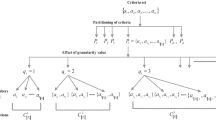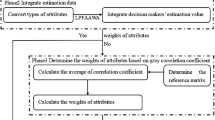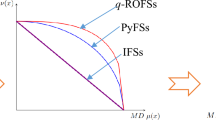Abstract
The main objective of this research is to study the integration of Analytic Hierarchy Process (AHP) into Delphi framework in neutrosophic environment and present a new technique for checking consistency and calculating consensus degree of expert’s opinions. In some pragmatism bearings, the experts might be not able to assign deterministic evaluation values to the comparison judgments due to his/her confined knowledge or the differences of individual judgments in group decision making. To overcome these challenges, we have used neutrosophic set theory to handle the integration of AHP into Delphi framework, where each pairwise comparison judgment is symbolized as a trapezoidal neutrosophic number. The power of AHP is enhanced by adding Delphi technique, since it can reduce noise which result from focusing on group and/or individual interests rather than concentriciting on problem disband and it also increase consensus degree about ideas. Obtaining a consistent trapezoidal neutrosophic preference relation is very difficult in decision making process because in creating a consistent trapezoidal preference relation; each expert should make \(\frac{{n \times \left( {n - 1} \right)}}{2}\) consistent judgments for \(n\) alternatives. When the number of alternatives is increasing, the workload of giving judgments for the experts is heavy and it makes them tired and leads to inconsistent judgments. In the proposed model,experts will focus only on \(\left( {n - 1} \right)\) restricted judgments and this also enhances the performance of AHP over the traditional version that is proposed by Saaty. A real life example is developed based on expert opinions about evaluation process of many international search engines. The problem is solved to show the validation of the suggested method in neutrosophic path.







Similar content being viewed by others
References
Abdel-Baset M, Hezam IM, Smarandache F (2016) Neutrosophic goal programming. Neutrosophic Sets Syst 11:112–118
Daneshvar Rouyendegh B (2011) The DEA and intuitionistic fuzzy TOPSIS approach to departments’ performances: a pilot study. J Appl Math
El-Hefenawy N, Metwally MA, Ahmed ZM, El-Henawy IM (2016) A review on the applications of neutrosophic sets. J Comput Theor Nanosci 13(1):936–944
Helmer O, Rescher N (1959) On the epistemology of the inexact sciences. Manag Sci 6(1):25–52
Hezam I M, Abdel-Baset M, Smarandache F (2015) Taylor series approximation to solve neutrosophic multiobjective programming problem. Neutrosophic Sets Syst 10:39–46
Jain V, Sangaiah AK, Sakhuja S, Thoduka N, Aggarwal R (2016) Supplier selection using fuzzy AHP and TOPSIS: a case study in the Indian automotive industry. Neural Comput Appl. doi:10.1007/s00521-016-2533-0
Kazemi S, Homayouni SM, Jahangiri J (2015) A fuzzy Delphi-analytical hierarchy process approach for ranking of effective material selection criteria. Adv Mater Sci Eng 2015:1–12
Kerlinger FN, Lee HB (1999) Foundations of behavioral research. ISBN-13: 978-0155078970
Kim M, Jang Y-C, Lee S (2013) Application of Delphi-AHP methods to select the priorities of WEEE for recycling in a waste management decision-making tool. J Environ Manag 128:941–948
Lewandowski D, Wu K, Sun X, Meng F (2011) Using a Delphi method and the analytic hierarchy process to evaluate Chinese search engines: a case study on Chinese search engines. Online Inf Rev 35(6):942–956
Liu W-K (2013) Application of the fuzzy Delphi Method and the fuzzy analytic hierarchy process for the managerial competence of multinational corporation executives. Int J e-Educ e-Bus e-Manag e-Learn 3(4):313
Liu F, Pedrycz W, Zhang W G (2016) Limited rationality and its quantification through the interval number judgments with permutations. IEEE Trans Cybern 99:1–13
Lv Y (2001) Research on scale system evaluation. AHP. In: System Engineering Society of China (ed) Theory and methods for decision science. Ocean Press, Beijing, pp 50–58
Lv YJ, Zhang W, Ceng XL (2003) Comparative study on exponential scale and 1–9 scale. Chin J Eng Math 20(8):77–78
Mahdi IM, Riley MJ, Fereig SM, Alex AP (2002) A multi-criteria approach to contractor selection. Eng Constr Archit Manag 9(1):29–37
Miller LE (2006) Determining what could/should be: the Delphi technique and its application. In: Meeting of the 2006 annual meeting of the Mid-Western Educational Research Association, Columbus
Saaty TL (2008) Decision making with the analytic hierarchy process. Int J Serv Sci 1(1):83–98
Saaty TL, Vargas LG (2006) Decision making with the analytic network process. Springer, Boston
Samuel OW, Asogbon GM, Sangaiah AK, Fang P, Li G (2017) An integrated decision support system based on ANN and Fuzzy_AHP for heart failure risk prediction. Expert Syst Appl 68:163–172
Sangaiah A, Thangavelu A (2013) An exploration of FMCDM approach for evaluating the outcome/success of GSD projects. Open Eng 3(3):419–435
Sangaiah AK, Jain V (2016) Fusion of fuzzy multi-criteria decision making approaches for discriminating risk with relate to software project performance. In: Handbook of research on fuzzy and rough set theory in organizational decision making 3:38
Sangaiah AK, Subramaniam PR, Zheng X (2015) A combined fuzzy DEMATEL and fuzzy TOPSIS approach for evaluating GSD project outcome factors. Neural Comput Appl 26(5):1025–1040
Sangaiah AK, Gopal J, Basu A, Subramaniam PR (2017) An integrated fuzzy DEMATEL, TOPSIS, and ELECTRE approach for evaluating knowledge transfer effectiveness with reference to GSD project outcome. Neural Comput Appl 28(1):111–123
Tavana M, Kennedy DT, Rappaport J, Ugras YJ (1993) An AHP-Delphi group decision support system applied to conflict resolution in hiring decisions. J Manag Syst 5(1):49–74
Wen J, Li D, Zhu F (2015) Stable recovery of sparse signals via lp-minimization. Appl Comput Harmon Anal 38(1):161–176
Wen J, Zhou Z, Wang J, Tang X, Mo Q (2016) A sharp condition for exact support recovery of sparse signals with orthogonal matching pursuit. In: Information Theory (ISIT), IEEE International Symposium, pp 2364–2368
Acknowledgements
The authors would like to thank the anonymous referees, Editor-in-Chief, and Associate Editors for their constructive comments and suggestions that have helped a lot to come up with this improved form of the paper.
Author information
Authors and Affiliations
Corresponding author
Ethics declarations
Conflict of interest
The authors declare that there is no conflict of interests regarding the publication of this paper.
Rights and permissions
About this article
Cite this article
Abdel-Basset, M., Mohamed, M. & Sangaiah, A.K. Neutrosophic AHP-Delphi Group decision making model based on trapezoidal neutrosophic numbers. J Ambient Intell Human Comput 9, 1427–1443 (2018). https://doi.org/10.1007/s12652-017-0548-7
Received:
Accepted:
Published:
Issue Date:
DOI: https://doi.org/10.1007/s12652-017-0548-7




